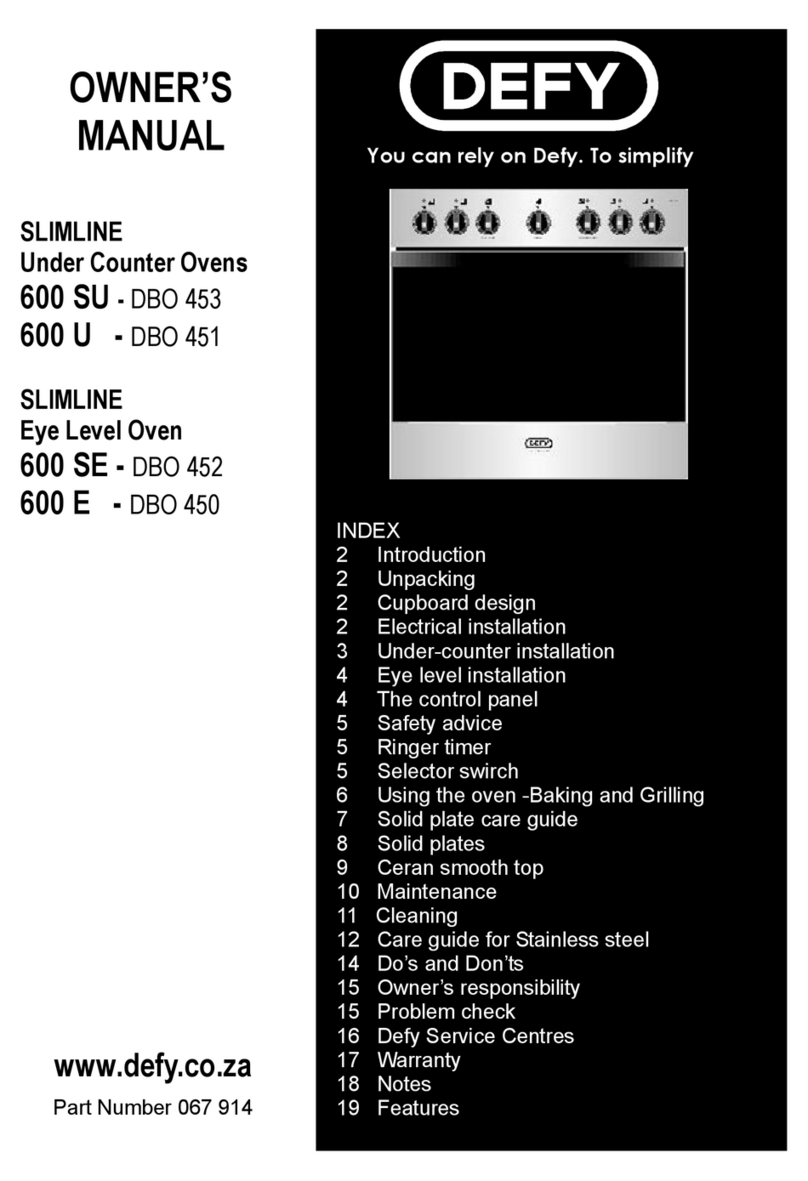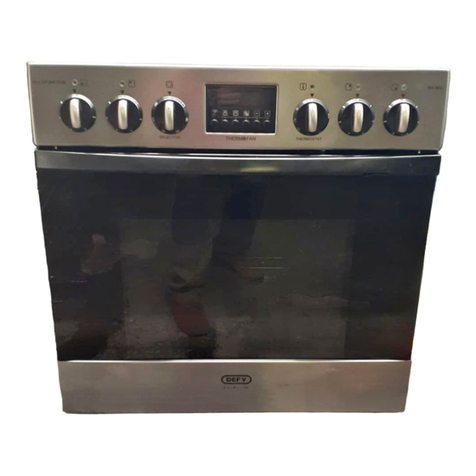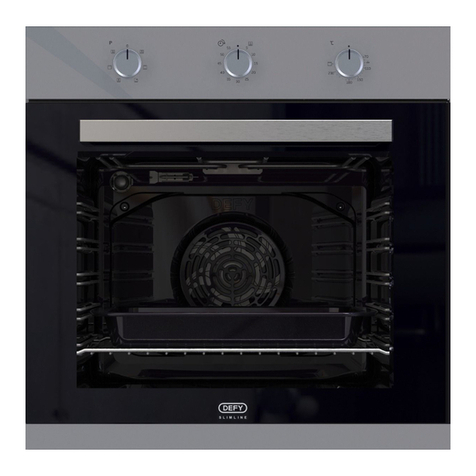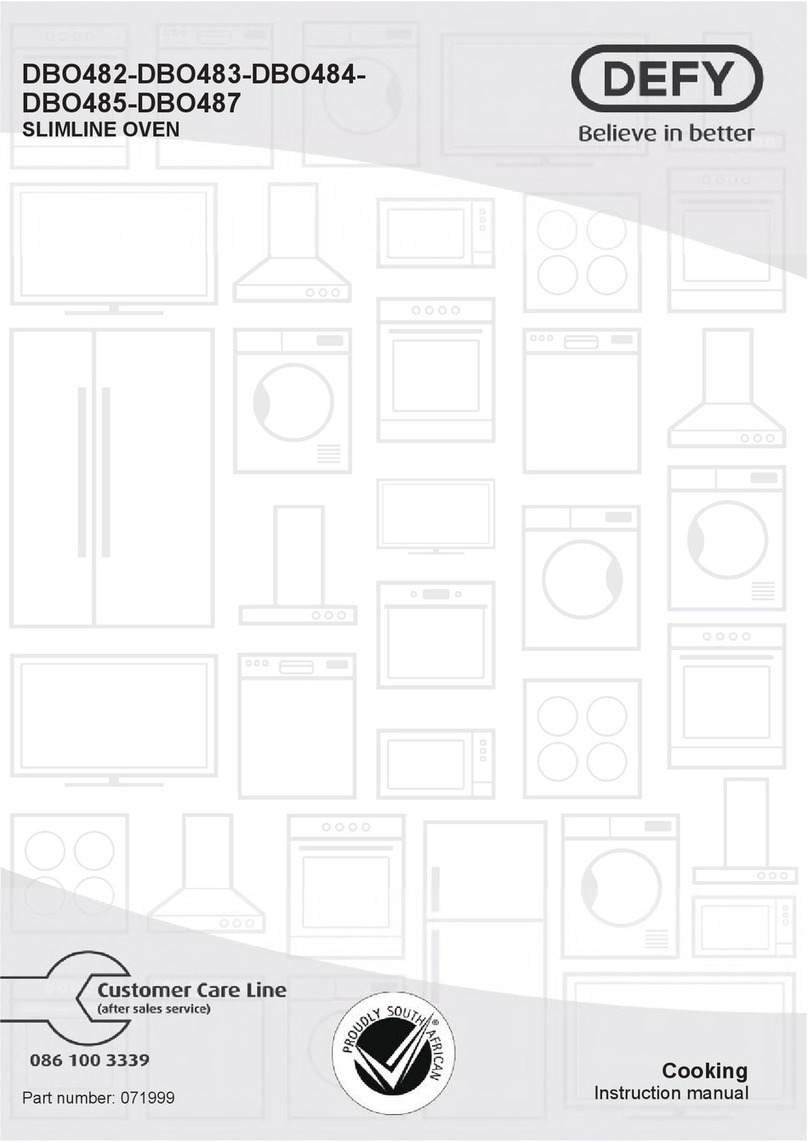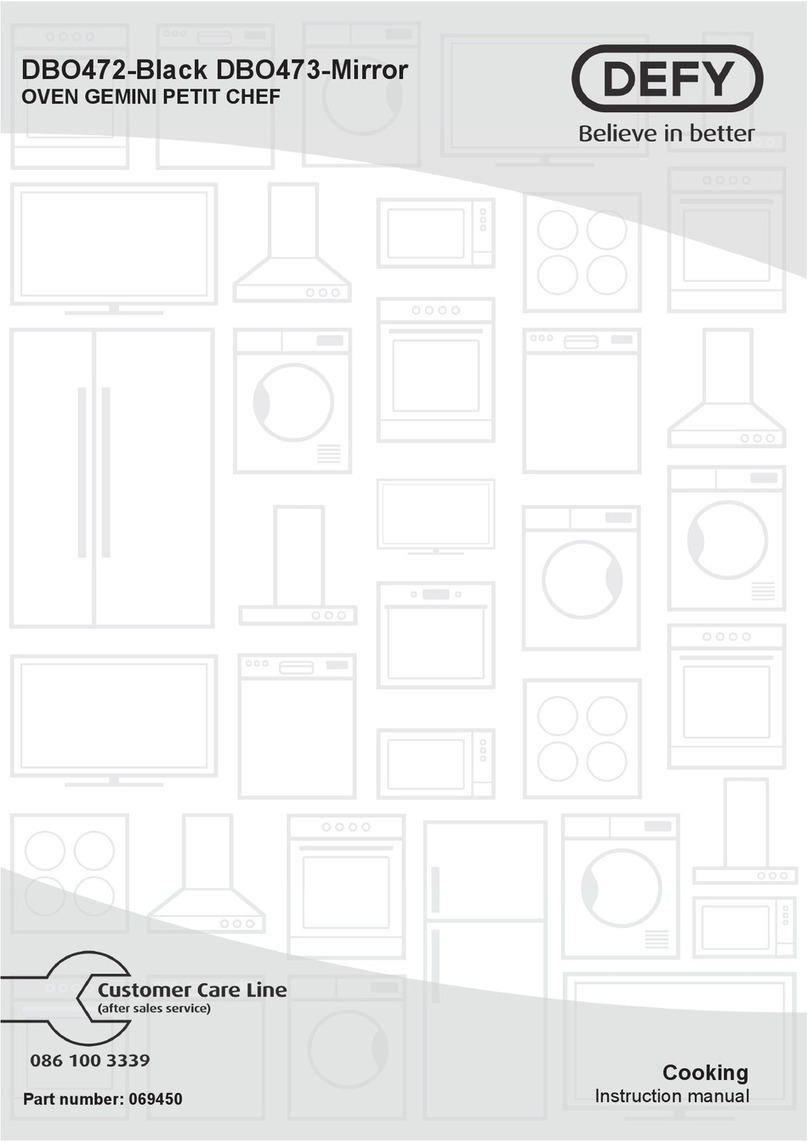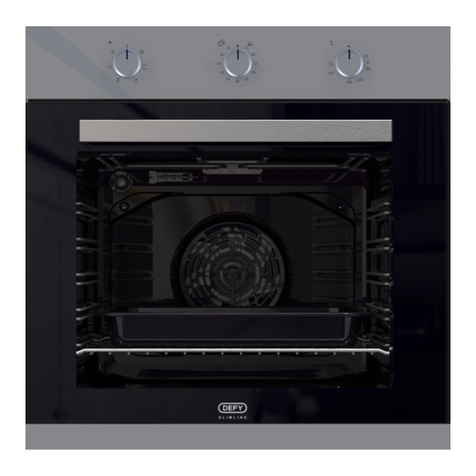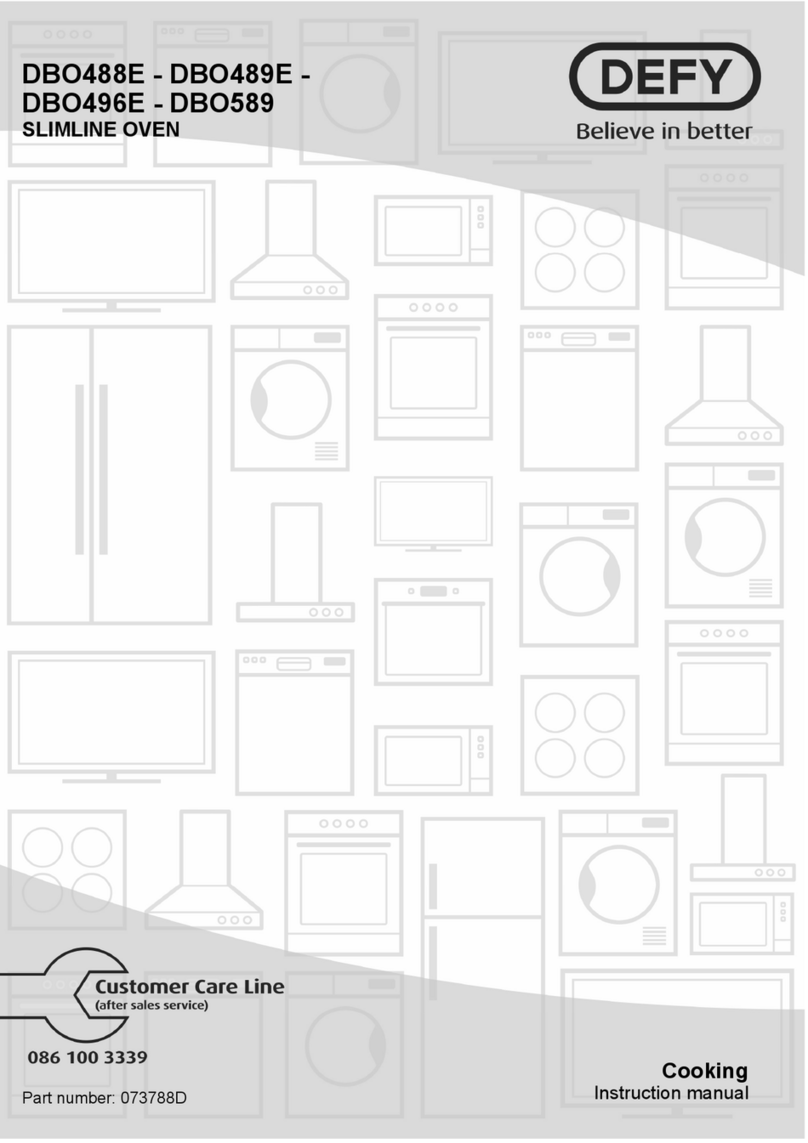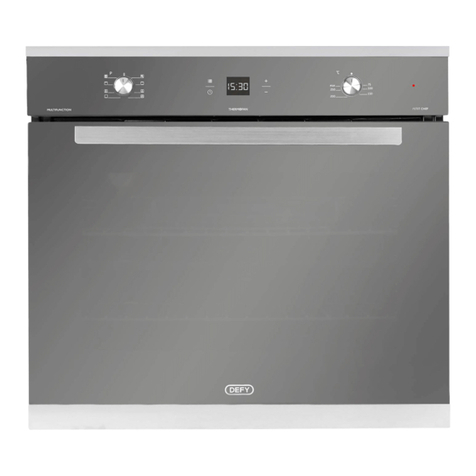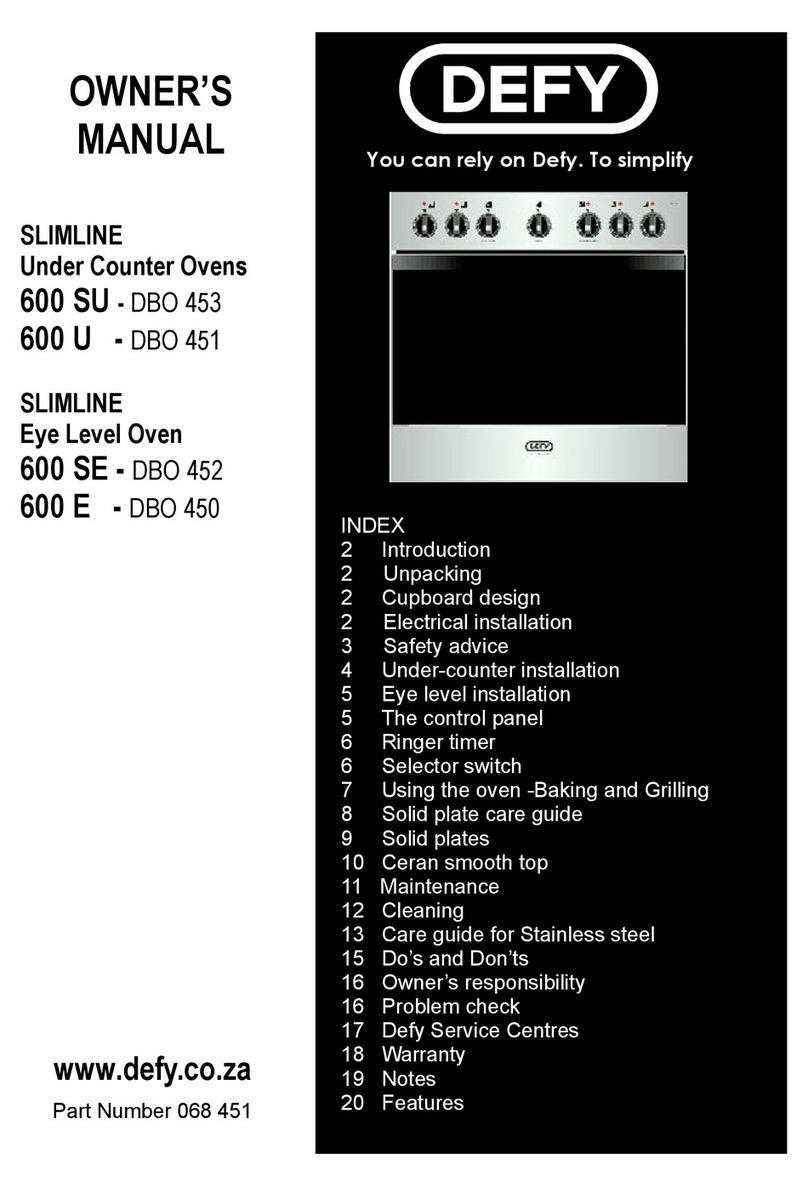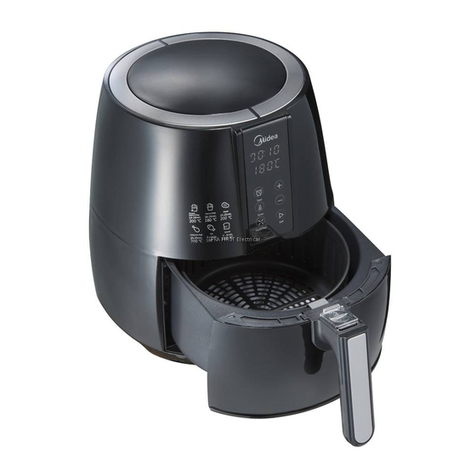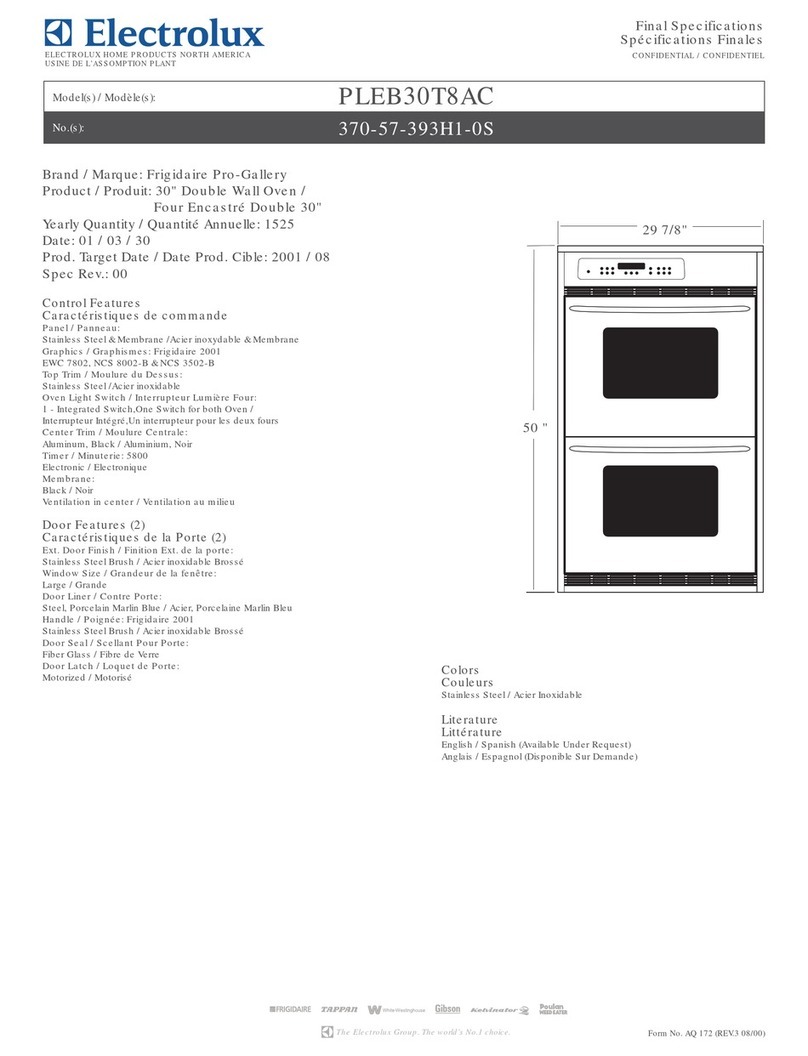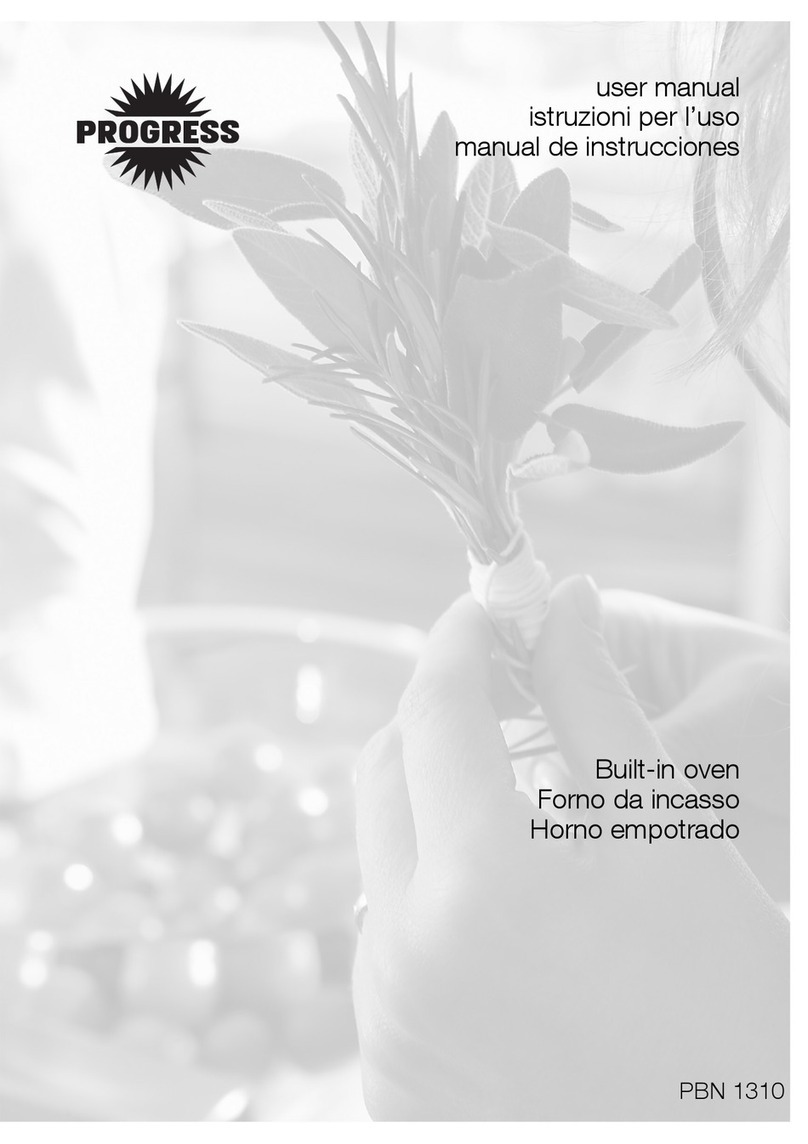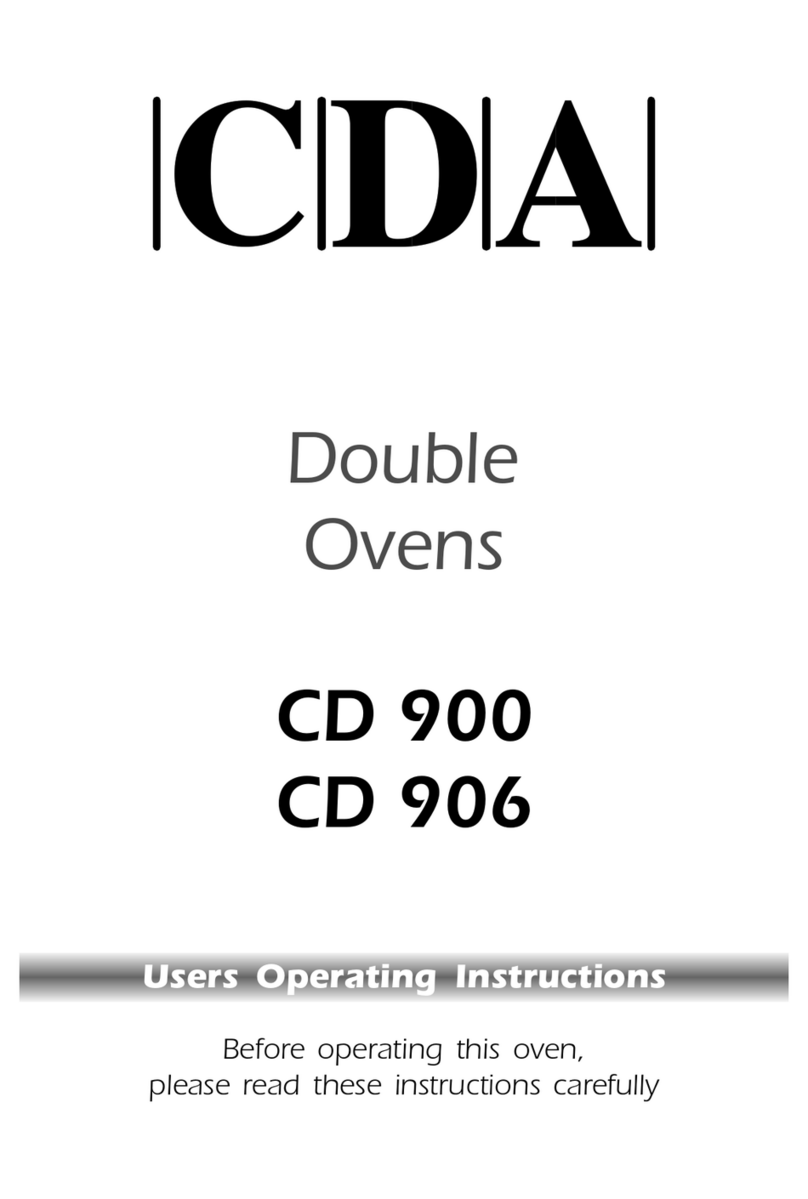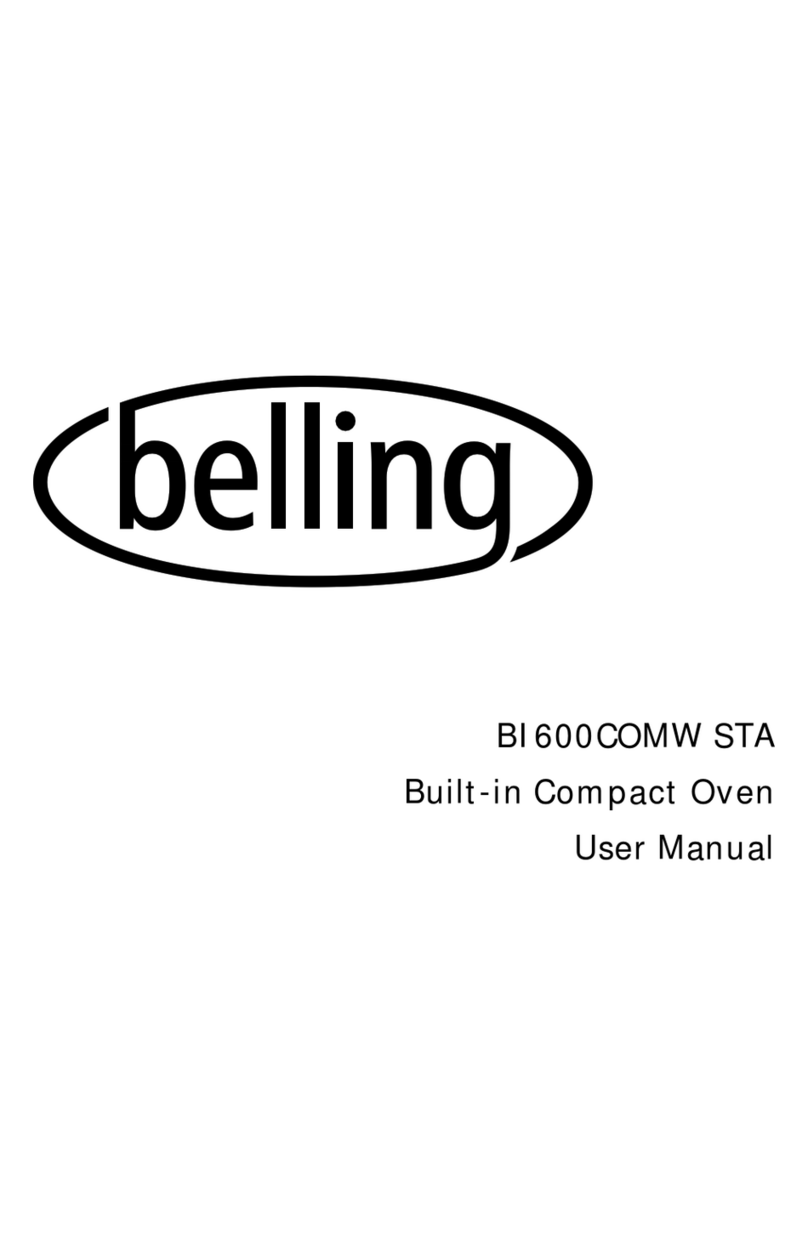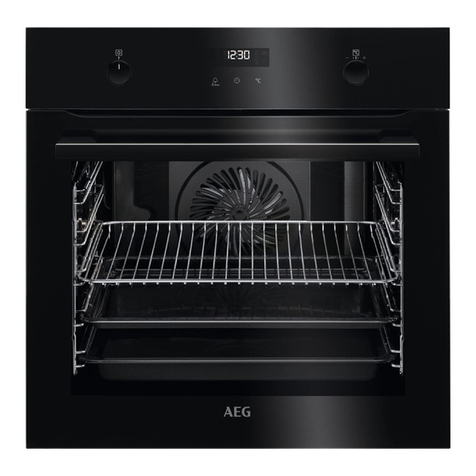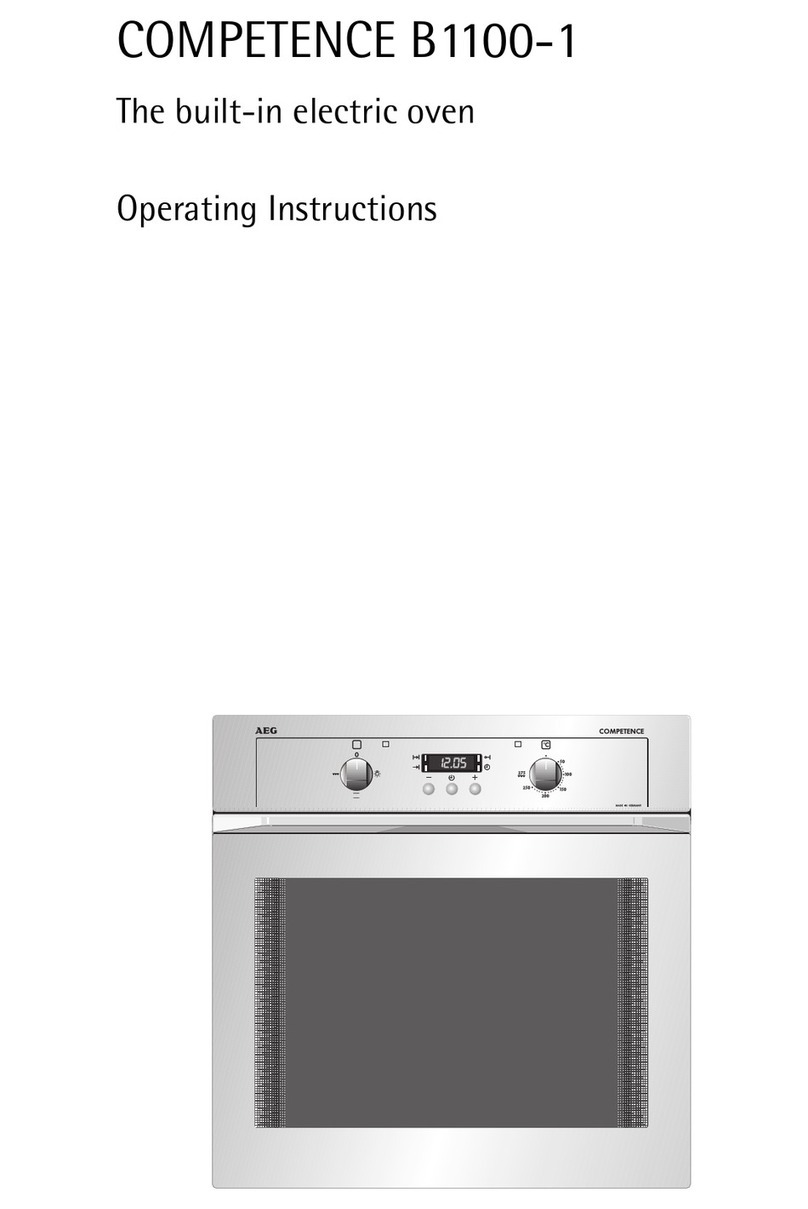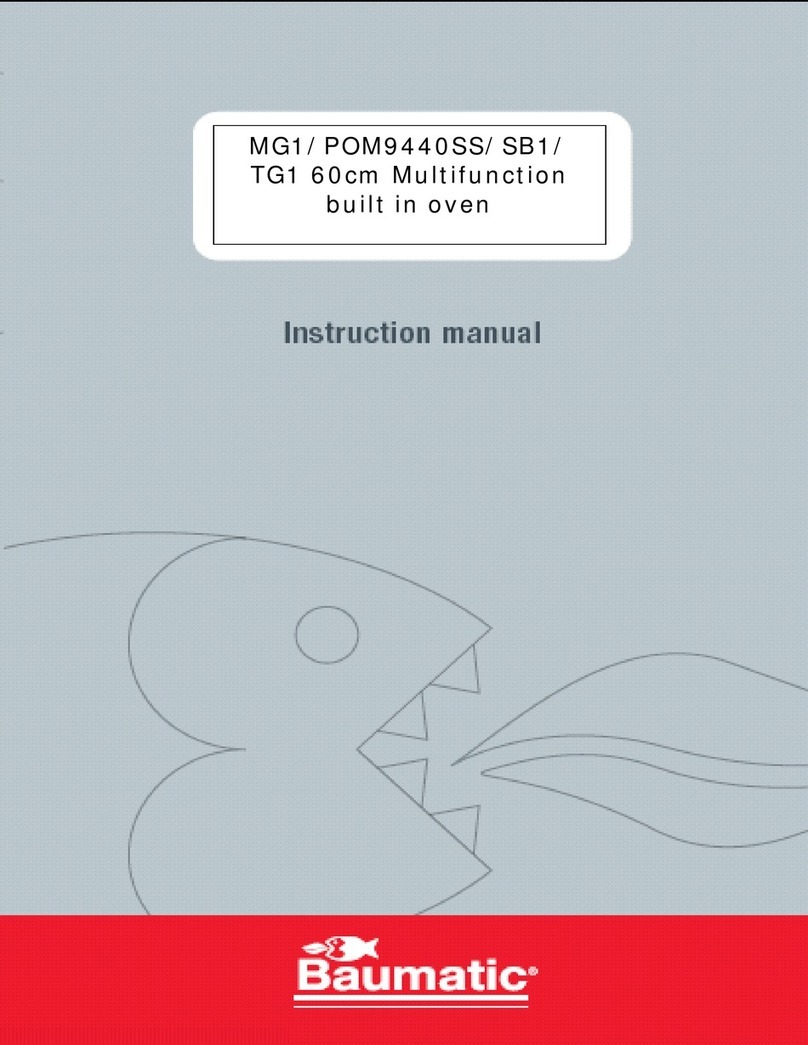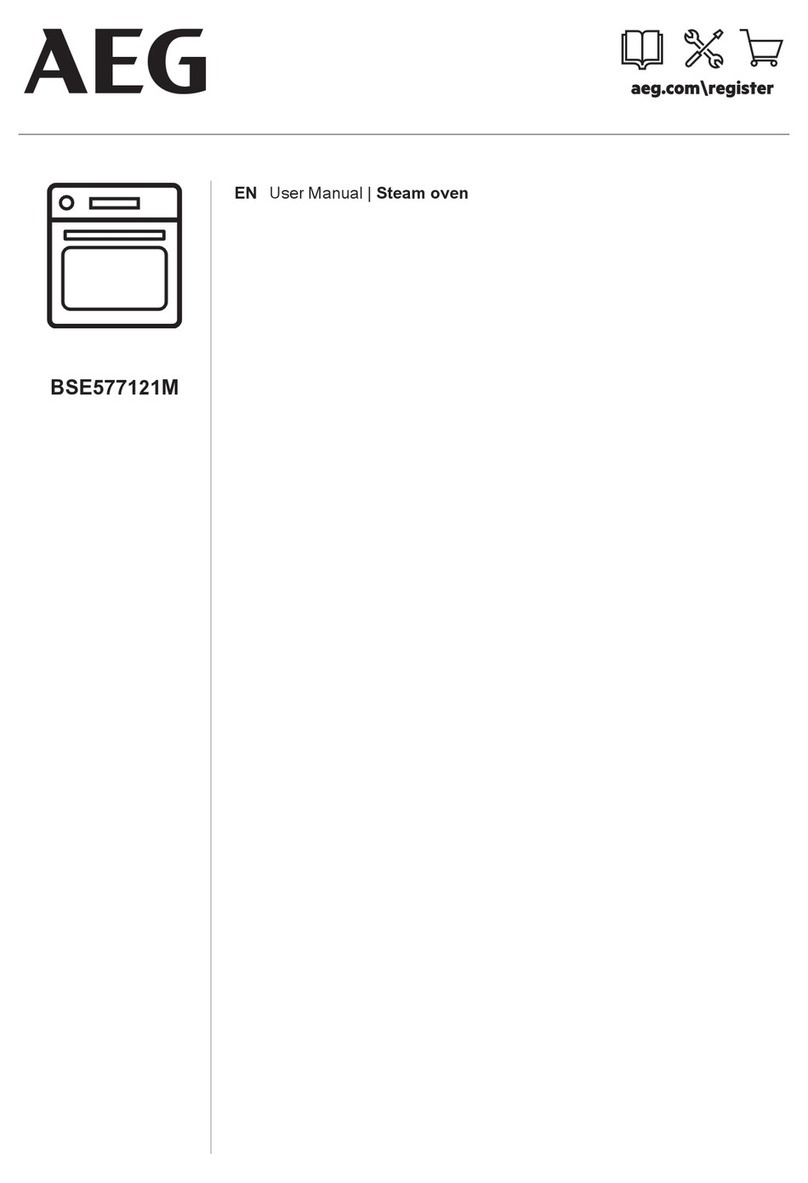Defy FLAMEMASTER DGS606 User manual

Page 1
FLAMEMASTER DGS606
600 GE 4B MULTIFUNCTION OVEN
Cooking
Instruction manual
Part number: 073307

Page 1
Contents
Dear Customer,
Your new Defy oven was manufactured in a state-of-the-art facility and has passed the strictest quality
control procedures.
Please read this manual carefully before connecting the gas bottle or using your oven for the first time
and then store it within easy reach for future reference.
This manual will provide you with information on how to operate and care for your oven to gain the
maximum benefit from it.
We trust you will enjoy years of trouble free use.
PERMIT NUMBERS
1037-56/1-RSA-12-A
Warning for hot surfaces
Warning for hazardous situations
Warning for risk of fire
Important information or useful hints about usage
EXPLANATION OF SYMBOLS
Throughout this User Manual the following symbols are used:
1. General Information 2
Overview 2
Technical specifications 2
Identification table 2
2. Important safety instructions 3
General safety 3
Safety when working with gas 4
3. Setup 5
Unpacking 5
Connecting the sprague to the oven 5
Connection to the power supply 5
Ventilation 6
Gas installation 6
Important information 6
Connecting the gas hose 6
Gas conversion 7
Routing of the gas hose 8
Anti-tilt mechanism 8
4. Operation Instructions 9
Oven operation 9
Selector switch 9
Cooking times table 9
Gas hobs 10
5. Maintenance and care 11
General cleaning 11
Service Intervals 11
Steam assisted cleaning 11
Caring for gas hobs 11
Replacing the oven light 11
Removing the oven door 12
Gas jet cleaning procedure 12
6. Important Notes 13
Problem solving guide 13
Do’s and don’ts 13
7. Support 14
Customer care line 14
Sub-Saharan Africa Branches 14
8. Warranty 15
PLEASE REGISTER YOUR
PRODUCT AT
www.defy.co.za
DEFY APPLIANCES (PTY) LTD
P.O.BOX 12004
JACOBS
DURBAN
4026
SOUTH AFRICA

Page 2
1. General Information
Overview
Technical specifications
GENERAL
External dimensions
(height / width / depth) 960 mm / 600 mm /
660 mm
Gas type / pressure LPG - G 30/2.8-3.0
kPa
Total gas consumption 8.0 kW
Oven power
consumption 3.4 kW
Grill power
consumption 1.8 kW
Control panel
Oven
thermostat Left front
burner Left rear
burner Right rear
burner Right front
burner
Ringer
timer
Selector
knob
Identification table
Position hob zone 2000 W
Rear left
(RL)
3000 W
Front
left (FL)
1000 W
Front
right (FR)
2000 W
Rear
right
(RR)
Gas type / Gas
pressure
NG - G 20/2.0 kPa 103 R 115 72 103
LPG - G 30/2.8-3.0 kPa 72 87 50 72
Accessories supplied may vary
depending on the model. Not all
accessories in the user manual may
be included with your appliance.
Accessories may be purchased from
Defy spares.
Figures in this manual are
schematic and may not match your
appliance exactly.
Rear left (RL)
2000W
Front left (FL)
3000W
Rear right (RR)
2000W
Front right (FR)
1000W

Page 3
2. Important Safety Instructions
This section contains safety instructions that will help you avoid risk of injury and damage.
All warranties will become void if you do not follow these instructions.
• Be careful when using alcoholic drinks in
your dishes. Alcohol evaporates at high
temperatures and may ignite and cause a
fire.
• Do not heat closed tins and glass jars in
the oven. The pressure that would build
up in the tin/jar may cause it to burst.
• Do not place baking trays, dishes or
aluminium foil directly onto the bottom of
the oven. The heat accumulation might
damage the bottom of the oven.
• Keep all ventilation slots clear of
obstructions.
• The appliance may be hot when it is in
use. Never touch the hot burners, inner
sections of the oven, heaters etc.
• Never touch the metal surfaces of the hob
and control panel during use.
• Always use heat resistant oven gloves
when putting in or removing dishes from
the hot oven.
• Do not use the appliance with the front
door glass removed or cracked.
• Do not trap the mains cable between the
oven door and frame and do not route it
over hot surfaces as the cable insulation
may melt and cause a fire as a result of a
short circuit.
• Make sure that the function knobs are
switched off after every use.
• Always dry food thoroughly before placing
it in hot oil or fat. Frozen food will splatter
if added too quickly.
• Only use the appliance for preparing food.
• Never heat fat or fry with a lid on the pan.
• Do not leave hot fat or oil unattended. If
overheating occurs, these could catch fire.
• Do not store flammable items in the oven.
• Always keep the oven door gasket clean.
General safety
• This appliance is not intended for use by
persons (including children) with reduced
physical, sensory or mental capabilities,
or lack of experience and knowledge,
unless they have been given supervision
or instruction concerning the use of the
appliance by a person responsible for
their safety.
• Children should be supervised to ensure
that they do not play with the appliance.
• Connect the appliance to an earthed
outlet/line protected by a fuse of suitable
capacity.
• The earth installation should be
completed by a qualified electrician. Our
company shall not be liable for any
problems arising due to the appliance not
being earthed in accordance with the local
regulations.
• If the supply cord is damaged, it must be
replaced by the manufacturer, its service
agent or similar qualified persons in order
to avoid a hazard.
• Do not operate the appliance if it is
defective or has any visible damage.
• Do not carry out any repairs or
modifications on the appliance.
• Never wash down the appliance with
water! There is a risk of electric shock!
• Never use the appliance when your
judgment or coordination is impaired by
alcohol and/or drugs.
• The appliance must be disconnected from
the mains during installation,
maintenance, cleaning and repair
procedures.
• The rear surface of the oven gets hot
when it is in use. Make sure that the gas
or mains connection does not come into
contact with the rear surface as
connections may get damaged.
• Use a deep pan, large enough to cover
the appropriate hob or burner.

Page 4
DANGER. Risk of explosion and
poisoning! Put out all naked
flames and do not smoke, strike
matches or do anything that
could cause ignition. Do not
operate any electric switches
(e.g. light switch, TV, computer,
cooker or door bell). Do not use a
telephone or mobile phone.
• The use of gas cooking appliances results
in the production of heat and moisture in
the room in which it is installed. Ensure
that the kitchen is well ventilated: keep
natural ventilation holes open or install a
mechanical ventilation device (mechanical
extractor hood).
• Gas appliances and systems must be
regularly checked for proper functioning.
The regulator, hose and its clamp must be
checked regularly and replaced within the
periods recommended by its manufacturer
or when necessary.
• Clean the gas burners regularly. The
flames should be blue and burn evenly.
• Good combustion is required in gas
appliances. In case of incomplete
combustion, carbon monoxide (CO) might
develop. Carbon monoxide is a
colourless, odourless and very toxic gas,
which has a lethal effect even in very
small doses.
Safety when working with gas
• Any work carried out on gas equipment
and systems may only be done by
authorised qualified persons who are
registered LPG Gas installers.
• Prior to installation, ensure that the local
distribution conditions (nature of the gas
and gas pressure) and the adjustment of
the appliance are compatible. In the event of a pan fire
• Switch off the Gas supply.
• Smother the flames with a blanket or
damp cloth.
• Burns and injuries are usually caused by
picking up the burning pan and rushing
outside with it.
• Do NOT use water to extinguish an oil or
fat fire.
If you smell gas
• Turn off all valves on gas appliances and
gas meter at the main control valve,
unless it's in a confined space or cellar.
• Extinguish all naked flames.
• Do not operate any electrical appliances.
• Ventilate the area. Open doors and
windows.
• Check for leaks. Check all tubes and
connections for tightness.
• If odour persists contact your nearest
Defy Service Centre for assistance.
• If you still smell gas leave the property.
• Warn the neighbors.
• Call the fire-brigade. Use a telephone
outside the house.
• If you have door or gates that are secured
by an electric lock, or entry phone, please
open these manually.
• Do not re-enter the property until you are
told it is safe to do so.
In the event of a burn back
• In the event of a burn back (where the
flame burns back into the jet ) immediately
turn off the control to the affected burner.
• Wait a few minutes and relight the burner
in the normal manner.
• If the burn back occurs again, turn off the
control knob to the affected burner, and
consult the nearest Defy service
technician, who will advise you.
Gas and electrical connections
must be carried out by qualified
personnel in accordance with
current and local regulations.
Installations carried out by
unauthorized persons will void
the warranty.
IMPORTANT: If the gas type of
the appliance is changed, then
the rating plate that shows the
gas type of the unit must also be
changed. the sticker that is
currently on the rear of the
appliance that reads “Factory
adjusted for LPG gas” must be
replaced by the sticker “Adjusted
for natural gas”. The new sticker
is in the gas jet kit supplied with
the appliance.

Page 5
Unpacking
Please ensure that packaging material is disposed
of in a responsible manner.
Plastic bags should be cut up to prevent children
playing with them and accidentally suffocating.
Remove all packing from the oven cavity and
position the accessories.
If the appliance is damaged in any way, do not
use it. Report the damage to your dealer, who will
take the necessary corrective action.
3. Setup
LPG Gas Only: Do not install this
appliance in a room below ground
level unless it is open to ground level
on at least one side. Failure to install
appliances correctly is dangerous
and could lead to prosecution.
Connecting the sprague to the oven
Purchase a standard plastic/metal saddle type
bracket, capable of going around the 20 mm
diameter sprague and with a hole pitch of 38
mm (Plastic) 45 mm (Metal), and two 4.2mm x
12mm self-tapping screws from your local
hardware store.
Feed the cables through the sprague and
connect to the mains terminal block of the
appliance.
Place the plastic/metal saddle around the
sprague and fasten via the 2 self-tapping
screws onto the factory pre-punched holes
adjacent to the mains terminal block of the
appliance.
WARNING! ELECTRICAL
CONNECTION MUST ONLY BE
DONE BY A QUALIFIED
ELECTRICIAN
Do not carry the product using the
oven door handle, this may damage
your oven door hinges!
You may lift the product with the door
open by holding the inside of the
oven and the back of the hob.
Connection to the power supply
This appliance should not be connected through
an earth leakage system. Refer to S.A.N.S.
10142.
This appliance has a ‘Y’ type supply cord
connection and must be installed by a licensed
electrician, who will ensure that the stove is
correctly connected and safely earthed.
The rated current is printed on the serial number
label attached to the stove upper back panel.
The appliance must be connected to the mains
through an All pole isolating switch which has a
minimum clearance between the contacts of 3
mm in All poles. A means for disconnection must
be provided in the fixed wiring.
12
3

Page 6
Gas Installation
The manufacturer and the seller do not accept
responsibility for any damage due to incorrect
installation or gas connection.
Gas bottles should be located outdoors in a
suitable ventilated lock-up. The connecting hose
should not exceed 200 cm in length.
Room size Ventilation opening
Smaller than 5 m3min. 100 cm2
5m3 to 10 m3min. 50 cm2
Greater than 10 m3not required
In the cellar or basement min. 65 cm2
Ventilation
Air for combustion is drawn from the room and the
exhaust gases are emitted directly into the room,
therefore good room ventilation is essential for the
safe operation of your appliance. If there is no win-
dow or door available for room ventilation, extra
ventilation must be installed.
The appliance corresponds to device class 1. The
following critical air gaps and ventilation openings
must be maintained:
Important information
Upon completion of the installation ensure that you
are familiar with the following:
a) The position of the isolation or shut-off valve in
the gas supply line to the appliance.
b) The requirements for safe operation of the
appliance
Ensure that pipe clamps are tightened correctly
and are of a good quality.
• Flexible hose
Any hose that is used to connect the stove to
the gas system shall comply with SANS 1156-2
or BS 3212.
• Gas cylinder - Not supplied.
For best results we recommend that gas cylin-
ders with a minimum capacity of 9kg be used.
• Regulator - Not supplied.
A 2.8-3.0 kPa LPG gas regulator which com-
plies with SANS 1237 must be used.
Failure to comply with the above will render the
warranty invalid.
Note: Your invoice is required in the event of
you wishing to make a warranty claim.
Connecting the gas hose
DANGER Risk of explosion!
Before starting any work on the gas
installation, please shut off the gas
supply.
• Have your appliance connected so that it will be
close to the gas connection. Ensure that there
is no gas leakage.
• Gas bottles should be located outdoors in a
suitable ventilated lock-up.
• The connecting hose to be used must not be
longer than 200 cm in length.
• Fit the clamp to the hose. Soak one end of the
hose (15 mm inner diameter) into hot water for
60 seconds to soften, then slip the softened end
of the hose completely onto the sharp hose tip
of the appliance.
• Secure the hose by tightening the hose clamp.
• Repeat the same procedure for the other end of
the hose by securing it to the regulator on the
gas bottle to complete the gas cylinder
connection.
• Always check for gas leaks after installation and
whenever a new or refilled gas bottle is used for
the first time.
This appliance is supplied ex-
factory with jets and air settings
for use with LPG gas only
A stove without a flame failure
device may only be used with a free
standing cylinder placed adjacent to
but not closer than 300 mm to the

Page 7
Leakage control at the connection point
• Ensure that the control knobs on the control
panel are in the OFF position.
• Open the valve on the Gas bottle.
• Using a small paint brush, apply some soapy
water to all the connections.
• If there is a leak, bubbles will appear.
• If this occurs, close the gas bottle valve .
• Check and tighten the connections
immediately.
• Repeat the procedure to ensure that there are
no further leaks.
1. Hose tip-LPG
2. Hose tip-NG
3. Safety hose
4. O-ring (gasket)
5. Clamp
DANGER Risk of explosion and
suffocation! LPG bottles must not
be stored in the house.
Caution: Never use a naked flame
to check for gas leaks.
DANGER Risk of explosion by
damage of the safety tube!
The safety tube must not be
clamped, bent or come into contact
with hot parts of the appliance.
Gas conversion
In order to have the appliance's gas type
changed, all the injectors must be changed and
the flame adjustment for all valves must be set
at the reduced flow rate position.
Changing the injectors
1. Take off burner cap and burner body.
2. Unscrew injectors by turning them
counterclockwise.
3. Fit new injectors.
4. Check all connections for secure fitting and
tightness.
The flames should be blue and burn
smoothly. If the flames appear
yellowish, check that the burner cap
is seated correctly or clean the
burner. Switch off the gas and let
burner cool before touching it.
Manifold
protection
plug
Manifold protector plug removal:
The manifold protection plug is inserted into the
manifold at factory level in order to protect the
manifold from being contaminated with debris.
The manifold protection plug must be removed
when the product is installed by the gas installer.
Manifold
1Flame failure device (model dependent)
2Spark plug
3Injector
4Burner
DANGER Risk of explosion or
poisoning by unprofessional
installation. Gas conversion must
only be carried out by a registered
installer.
Unless there is an abnormal
condition, do not attempt to remove
the gas burner taps. You must call
an authorised service agent if it is
necessary to change the taps.
New injectors have their position
marked on their packing or refer to
the Injector table.

Page 8
Reduced gas flow rate setting for taps
1. Ignite the burner that is to be adjusted and
turn the knob to the reduced position.
2. Remove the knob from the gas tap.
3. Use an appropriately sized screwdriver to
adjust the flow rate adjustment screw. For
LPG (Butane - Propane) turn the screw
clockwise. For natural gas, you should turn
the screw counter-clockwise once. The
normal length of a straight flame in the
reduced position should be 6-7 mm
4. If the flame is higher than the desired position,
turn the screw clockwise. If it is smaller turn
anticlockwise.
5. For the last control, bring the burner to both
the high-flame and reduced positions and
check whether the flame is on or off.
Depending on the type of gas tap used in your
appliance the adjustment screw position may
Routing of the gas hose
Before connecting the gas hose, make sure that
the gas hose outlet behind the product is in the
same direction as the hose outlet
X
X
X
• “A” 1 x Stability chain
• “B” 1 x Stability hook with anchor sleeve
• “A” is factory fitted at the rear of the stove in
the centre. (See overleaf for instructions if the
removable splashback is to be fitted)
• Position the stove and move “A” to touch the
wall behind the stove.
• Mark the hole where “A” touches the wall
behind the stove.
• Move the stove away from the wall to allow for
an area to work in.
All stoves can tilt if you or a child sit or lean on an open oven door. Safety regulations
stipulate that the ANTI-TILT mechanism supplied with the stove, must be fitted as shown.
• Using a 8.0 mm concrete bit, drill a hole at
the marked position.
• Using the Stability hook and anchor sleeve
“B”, firmly secure “B” to the wall.
• Slide the stove back in position and engage
the stability chain “A” onto the Stability hook
“B”.
• The stove is then secured and will not
accidentally tilt if downward pressure is
applied to the open oven door.
Anti-tilt mechanism

Page 9
4. Operation Instructions
Selector switch
0Off Switches the Oven off
Operating
with fan
(Defrost)
Switches the fan on for thawing
frozen food or cooling cooked food
Convention
al Bake Baking is recommended on one
level only.
This mode is recommended for
cakes, pastries and casseroles
Fan
assisted
cooking
Heat from the top and bottom
elements is rapidly and evenly
distributed by the fan. For cooking
two meals on different shelf levels
Thermofan
heating Heat from the top rear element is
rapidly and evenly distributed by
the fan. For cooking two meals on
different shelf levels
Static Bake
& Steam
Assisted
Clean
Recommended for dishes that
require further cooking at the
center or the base
Turbo grill Suitable for grilling small amounts
of food quickly
Full grill Suitable for grilling large amounts
of food
3D
Function &
steam
assisted
cooking
Top heating, bottom heating and
Thermofan heating are in
operation. Food is cooked evenly
and quickly all around. Cook with
one shelf only
Oven operation
Set the function knob to the desired operating
mode. See page 5 for functions.
Set the temperature knob to the desired
temperature. The thermostat indicator light will
glow and remain on until the oven has reached
the selected temperature.
The indicator light will then switch between off
and on as the thermostat maintains the selected
temperature.
Note:
The oven thermostat is marked to 70°C. When
set to this position, the oven may be used as a
warmer.
Baking / Roasting
Set the selector knob to the desired mode.
Set the oven thermostat to the desired
temperature.
Once the thermostat indicator light turns off,
preheating is complete.
Thereafter place the food in the oven on the
middle shelf where possible.
Grilling
Both the wire shelf and roast pan may be used
for grilling. If you are grilling on the wire shelf,
use the baking tray on the lower rack as a drip
tray.
Position the shelf in the desired position below
the grill element. Set the selector switch and
oven thermostat to their respective grill positions.
Preheat the grill element for about 5 minutes.
Place the food in the center of the shelf and
monitor the grilling to avoid burning the food.
Foods that are not suitable for
grilling create a fire risk. Only grill
food which is suitable for intensive
grilling heat.
Ringer timer
The ringer timer can time a period of up to 60
minutes. First wind the timer by turning the knob
fully clockwise. Return the knob to the desired
time period. Note: If the timer is not first fully
wound the bell may not ring.
Dish Acc. pos. P°C Time
Sponge
cake Cake
Tin** 1&4 170°C 20 Min
Cup-
cakes Muffin
Tin** 1&4 170°C 22 Min
Biscuits Bake
Tray* 1&4 170°C 22 Min
Chicken
breasts
(150 g)
Roast
Pan* 4Max 20 Min
Roast
chicken
(1.3 kg)
Roast
Pan* 1180°C 70 Min
Pizza Wire
Shelf* 2190°C 8 Min
Cooking times table
Timings in this table are meant as a guide.
*These accessories may not be included with your
product
**These accessories are not included with your
product. They are commercially available.

Page 10
The size of the cooking vessel and the flame must be
suited to each other. Adjust the gas flames so that they
do not extend past the bottom of the cooking vessel
and ensure that the cooking vessel is centered on the
saucepan carrier.
Igniting the gas burners
Burner is equipped with automatic ignition.
• Keep the burner knob pressed in.
• Turn it counter clockwise to the large flame
symbol.
• Ignite the hob by pressing the automatic
ignition.
• Adjust it to the desired cooking power.
Gas hobs
Turning off the gas burners
Turn the knob to off (upper) position.
BURNER BODY
BURNER CAP
FLAME FAILURE SENSOR IGNITION
ELECTRODE
IGNITION ELECTRODE
FLAME
FAILURE
SENSOR
Incorrect Correct
Fitting the burner caps
• Carefully align the hole in the burner body
with the flame failure sensor.
• Gently lower the burner body into position.
• Centralise and level the burner cap onto the
burner body. (The burner cap must be
positioned so that it rests centrally on the
burner body). Ensure that it is correctly
seated. Refit the pot stands.
Wrong centralizing of the burner caps
may result in a flash back and cause
burners to melt and deform.
Wrong control of the gas valves: Gas
valves must be controlled from 90° to
210° (or 160° according to the gas valve
model) If flame is set from 0° to 90° the
burner will be below the minimum output
and may result in a flash back and cause
burners to melt and deform.
The above user faults are not covered by
the warranty.
WARNING: Unattended cooking on
a hob with fat or oil can be
dangerous and may result in a fire.
Danger of fire: Do not store items on
the cooking surface.
CAUTION: The cooking process
has to be supervised. A short term
cooking process has to be
supervised continuously.
Use only pots with a solid level
base. An uneven base can prolong
cooking times and waste energy.

Page 11
5. Maintenance and Care
Service intervals
• Every twelve months the appliance should be
serviced by a Defy Service agent to ensure
continued efficient and safe operation.
• If required, the cleaning of the valves should
only be carried out by a qualified Defy
technician. i.e. Burner not functioning correctly.
• Wash removable burner parts weekly with hot
water and detergent.
• Remove any encrustations and ensure that the
burner holes are clear.
• The condition of the gas hose and valve must
be inspected for leaks when the gas bottle is re-
filled.
Steam assisted cleaning
• Pour 100 ml of water into the emboss on the
oven floor.
• Select the steam assisted cleaning function.
• Turn the oven on to run this cycle for 5 minutes.
• At the end of the cycle, wait 5 minutes before
opening the door.
• Open the door and wipe the inner surfaces of
the oven with a damp sponge or cloth.
• Use warm water with washing liquid, a soft cloth
or sponge to clean persistent dirt and wipe it
with a dry cloth.
General cleaning
• Wipe down glass panels, cabinet, door, control
knobs, trims and handles with a hot soapy
cloth. Do not use a steam cleaner.
• Use only liquid household cleaners and avoid
abrasive powders or scouring pads.
Caring for gas hobs
• Remove the burner caps and wipe them with
a thin damp cloth or non-abrasive sponge.
• Remove and clean the saucepan carriers and
the hob.
• Dry burners afterward and blow away any
residual water in the gas outlet holes.
• Install the burner caps and make sure that
they are seated correctly.
Replacing the oven light
The oven light is switched on by the oven
thermostat and switches off when the thermostat
knob is returned to 0.
To replace a faulty light bulb:
• Switch off the power at the wall isolator to
avoid the possibility of electric shock.
• Unscrew the light cover.
• Unscrew the faulty bulb and fit a new 25-watt
bulb rated for 300’C
• Refit the light cover.
DANGER Risk of electric shock!
Switch off the electricity before
cleaning the appliance.
Important! Any food residue must be
removed from the bottom of the
cavity before you start steam assisted
cleaning. Remove all oven
accessories.
The surface of the appliance may be
damaged by some detergents or
cleaning materials. Do not use
aggressive detergents, cleaning
powder, cream or any sharp objects.

Page 12
Gas Jet Cleaning Procedure
• The gas jets on your hob should be cleaned
every 6 months.
• This may be done using a Gas Jet Cleaning
Kit which may be purchased from your
nearest Defy Service Centre.
• The kit comprises of a sliding T-bar (A) a
socket (B) and a ‘Classic pin’ (C).
• Fit the T-bar to the socket and remove the
pot stands, burner caps and burner
bodies.
1. Insert the socket into the central tube of the
burner so that it locates over the brass gas jet
at the bottom of the tube.
2. Gently loosen the brass gas jet by turning the
socket in an anti-clockwise direction.
3. Carefully lift the socket and loosened brass
gas jet from the central burner tube.
4. Insert the Classic pin into central hole of the
jet and slide it up and down until the jet is free
of accumulated dirt.
5. Re-assemble in reverse order.
Removing the Oven Door Glass
A. Press clips on both ends of the top décor.
B. Lift the top décor & remove from door.
C. Lift the glass to a 45 degree position and pull
towards yourself.
The front door inner glass is coated
with an easy clean material. Do not
use any harsh abrasive cleaners,
hard metal scrapers, scouring pads or
bleach to clean the front door inner
glass as they may scratch the surface
and destroy the coating material.
These steps should be carried out in
reverse order to install the door. Do
not forget to close the clips at the
hinge housing when reinstalling.
Removing the oven door
The oven door may be removed to improve oven
access during cleaning.
Open the front door (1).
Push down the clips at the hinge housing (2)
on the left and right hand sides of the front
door by pressing them down as illustrated in
the figure.
AB
3. Open the door to halfway.
4. Remove the door by pulling it upwards to
release it from the hinges.

Page 13
6. Important Notes
Problem solving guide—before calling for technical support
There is no gas:
Main gas valve is closed. Open the gas valve.
Gas pipe is bent. Ensure the gas pipe has
been properly fitted.
Burners are not burning properly or at all:
Burners are dirty. Clean burner components.
Burners are wet. Dry the burner
components.
Burner cap is not mounted
safely. Mount the burner cap
properly.
Gas valve is closed. Open gas valve.
Gas cylinder is empty
(when using LPG). Replace the gas cylinder.
The burners will not light:
The gas pipe is twisted,
bent or kinked. Ensure the gas pipe has
been properly fitted.
The burners are dirty or
wet. Clean / dry the burner
components.
The gas cylinder is empty. Replace the gas cylinder.
The burner caps are not
fitted correctly. Fit the burner caps
correctly.
The gas pressure
regulator is closed. Check to see if the
regulator is open.
Lighting procedure not
been correctly followed. Follow the correct lighting
procedure.
The flame is yellow, pots and pans are stained:
The burners are dirty or
wet. Clean / dry the burner
components.
The gas is running out. Replace the gas cylinder.
The burner caps are not
fitted properly. Fit the burner caps
properly.
The gas pipe is twisted,
bent or kinked. Ensure the gas pipe has
been properly fitted.
Smell of leaking gas: Smell of leaking gas:
Are all the control knobs in
the off position? Check to see the knobs
are in the off position.
The gas pipe is fitted
incorrectly. Ensure the gas pipe has
been properly fitted.
The hose clamps require
tightening or replacing. Have hose clamps
tightened or replaced.
The regulator is faulty and
needs to be replaced. Have regulator checked
and replaced.
Do
• Clean your appliance regularly.
• Use flat-bottomed pots and pans when
cooking on the hotplates. This will maximize
efficiency and reduce electricity costs.
• Leave about a 40 mm. air gap between
baking tins and the oven walls. Adequate air
circulation is important for good baking
results.
• Get into the habit of wearing oven gloves
when handling utensils in a hot oven. This will
help to avoid accidental burns.
• Partly slide out the oven shelf before
removing hot dishes. This prevents accidental
contact with the hot oven sides.
Don’t
• Use pots which are smaller than the hotplate
diameter. This wastes electricity and allows
the pot handles to overheat.
• Place anything on the open oven door. The
glass is not a work surface and could get
scratched.
• Use the appliance to heat the home. Neither
the hotplates nor the oven was designed for
this purpose and damage could occur.
• Allow pot handles to overhang the front of the
appliance. Children might be tempted to grab
them with harmful consequences.
OVER THE YEARS, DEFY'S SERVICE CENTRES HAVE IDENTIFIED THIS LIST OF DO'S AND
DON'TS AS BEING IMPORTANT FOR CUSTOMER SATISFACTION AND SAFETY. PLEASE READ IT
AND FAMILIARISE YOURSELF WITH ITS CONTENTS.
The oven may emit steam during use.
This is normal and is not a fault.
When metal parts are heated, they
may expand and cause noise. This is
not a fault.
Never try to extinguish a fire with
water! When oil has caught fire,
immediately cover the pot or pan
with a lid. Switch off the hob if safe
to do so and phone the fire service.
Do NOT engage ringer timer control
knob in anti-clockwise direction from
the "0" position.

Page 14
Customer care line
If you still have a problem after following all the
instructions, contact the customer care line on
086 100 3339. They will be able to advise you on
any aspect of the appliance.
7. Support
Sub-Saharan Africa Branches
ZAMBIA: SOUTHGATE INVESTMENTS LTD
Plot 1606, Sheki Sheki Road
P.O. Box 33681
Lusaka, 10101, Zambia
Tel: +260 0211 242332/3
Fax: +260 0211 242933
sgiservicecentre@microlink.zm
NAMIBIA: ATLANTIC DISTRIBUTORS
C/O Edison and Einstein Street
Southern Industrial
Windhoek
Namibia
Tel: +264 61 216 162
Fax: +264 61 216 134
Email: atlantic@mweb.com.na
ZIMBABWE: TRADECOMAFRICA
Trade Com Africa, 183 Loreley Crescent
Msasa, Harare, Zimbabwe
Tel: +263 4 486165/6
Cell: +263 772 469010
Cell: +263 772 469011
BOTSWANA: RAY MORGAN AGENCIES
Plot 48, East Gate
Gabarone International Commerce Park
Kgale View
Gaborone
Botswana
Tel: +267 390 6476
Fax: +267 395 9705
Email: service@rma.co.bw
SWAZILAND: LYNDS DISTRIBUTORS
Lot 581 King Sobhuza the 2nd Avenue
Unit 4 & 5 SIDC factory Shells
Matsapha
Eswatini
Tel: +268 2518 4310
Fax: +268 251 4318
MOZAMBIQUE: COOL WORLD. LDA
Rua da Resistencia No. 97B R/C
Cell: +258 84 44 61 234
coolw[email protected]
Nosso Show Room
Do not attempt any repairs yourself. Before calling a service technician, please check:
• The mains distribution board for tripped circuit breakers.
• The wall switch is on.
• Gas fittings are connected properly.
Remember that you may be charged for a service call even during the warranty period if the fault is due to
or caused by any of the above.
If the problem cannot be remedied after
following the troubleshooting problem
solving guide, please consult with an
authorised service agent or the dealer
where you purchased the appliance.
Never attempt to repair a defective
appliance yourself.

Page 15
8. Warranty
This certificate is issued by DEFY APPLIANCES (PTY) LTD manufacturers of Defy and Ocean
products, hereinafter the Company, to the original purchaser only, of the appliance described on the
certificate and shall constitute the only warranty given in respect of this appliance.
The Company warrants to the original purchaser that for a period of THREE YEARS from date of
purchase the appliance is free from defect under normal domestic use, both in workmanship and
material, subject to the following conditions.
1. Repair or replacement of any part of this appliance, found by the Company to be defective, shall
be at the election of the Company. The Company reserves the right to effect such service through
any of its Service Divisions or Authorised Service Dealers. The cost of such service shall be borne
by the Company in full, provided that the appliance is located no further than 50 km from a
Company Service Centre or an Authorised Service Dealer. Where the appliance is located beyond
the 50 km radius, the purchaser shall be liable for the standard travelling charges, as determined by
the Company.
CARRY IN SERVICE Microwave ovens, Compact cookers and small appliances are repaired in our
service centres and are not collected from the customers home. Faulty units must be delivered to
the purchasing dealer or to the nearest Company Service Centre for warranty repairs.
2. Rusted or corroded plates, vitreous enamelware, fuses and lamps are specifically excluded from
these warranties. It is an express condition of these warranties that the purchaser takes due care
and attention in the use and maintenance of the appliance. Abuse, misuse in conflict with operating
instructions, connection to incorrect voltages and subjection to commercial use shall release the
Company from its obligations.
3. This warranty shall become void and cease to operate if the appliance is dismantled by, or any
repairs to the appliance are effected by any persons not duly authorised by the Company, or if
substitute parts not approved by the Company are used in the appliance, or if the serial number of
the appliance is removed.
4. The Company shall not be responsible for damages resulting from fire, flood, civil disturbances or
any Act of God. The Company shall not, in terms of these warranties be responsible nor held liable
for any consequential loss or damage of any kind caused by or due to the failure or malfunction of
the appliance. The Company shall not be responsible for damages caused by insect and/or animal
infestation.
5. The Company shall not be responsible for transportation or other costs other than those incurred
within the provisions of Point 1 of this Certificate.
6. For warranties in the Republic of South Africa and Sub-Saharan Africa, please contact the
customer care line. Please refer to the previous page for respective South African branches
and Sub-Saharan Africa branches.
7. Where service is requested under warranty and no fault or defect can be found by the Company,
all costs incurred will be for the purchaser's account.
8. This Certificate as well as your invoice will serve as proof of purchase. For the purpose of
warranty, it will be essential to produce this Certificate and invoice. Failure to do so, will render the
purchaser liable for service costs.
KEEP THIS CERTIFICATE AND SALES INVOICE AS PROOF OF PURCHASE FOR WARRANTY
PURPOSES.
Table of contents
Other Defy Oven manuals
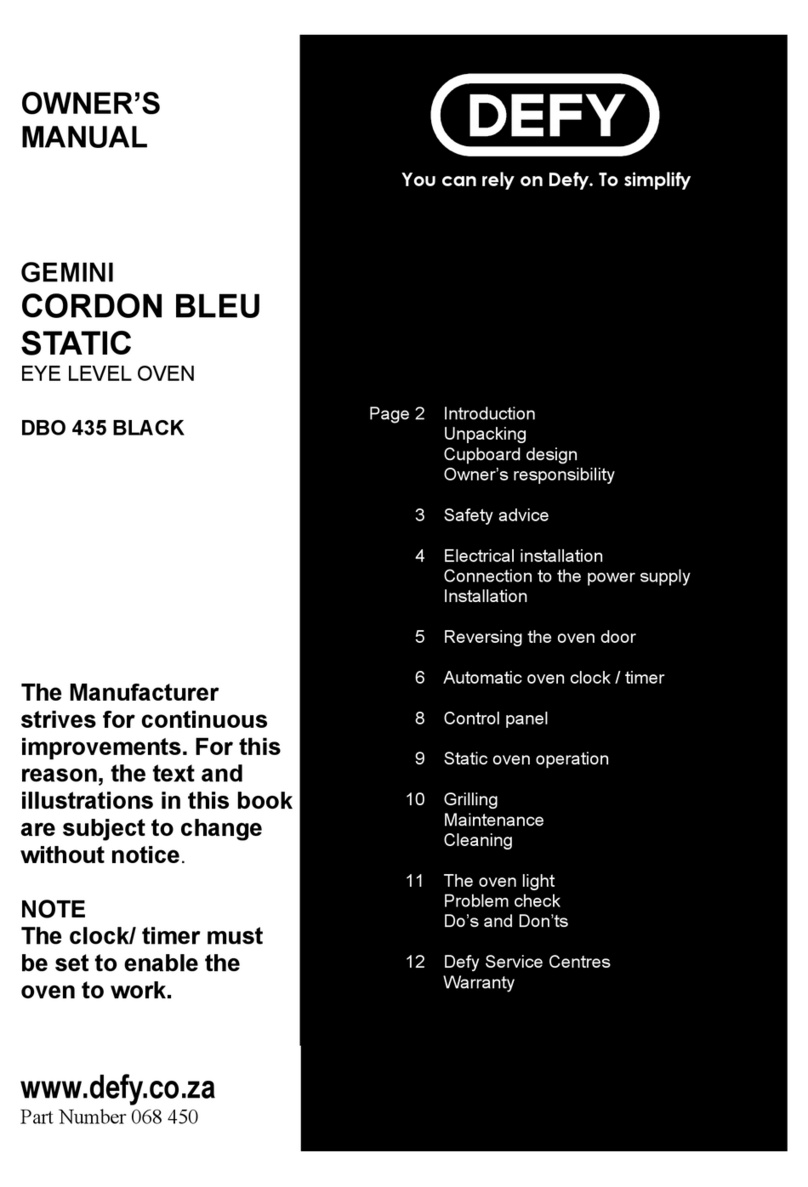
Defy
Defy DBO 435 Black User manual

Defy
Defy 600STE User manual
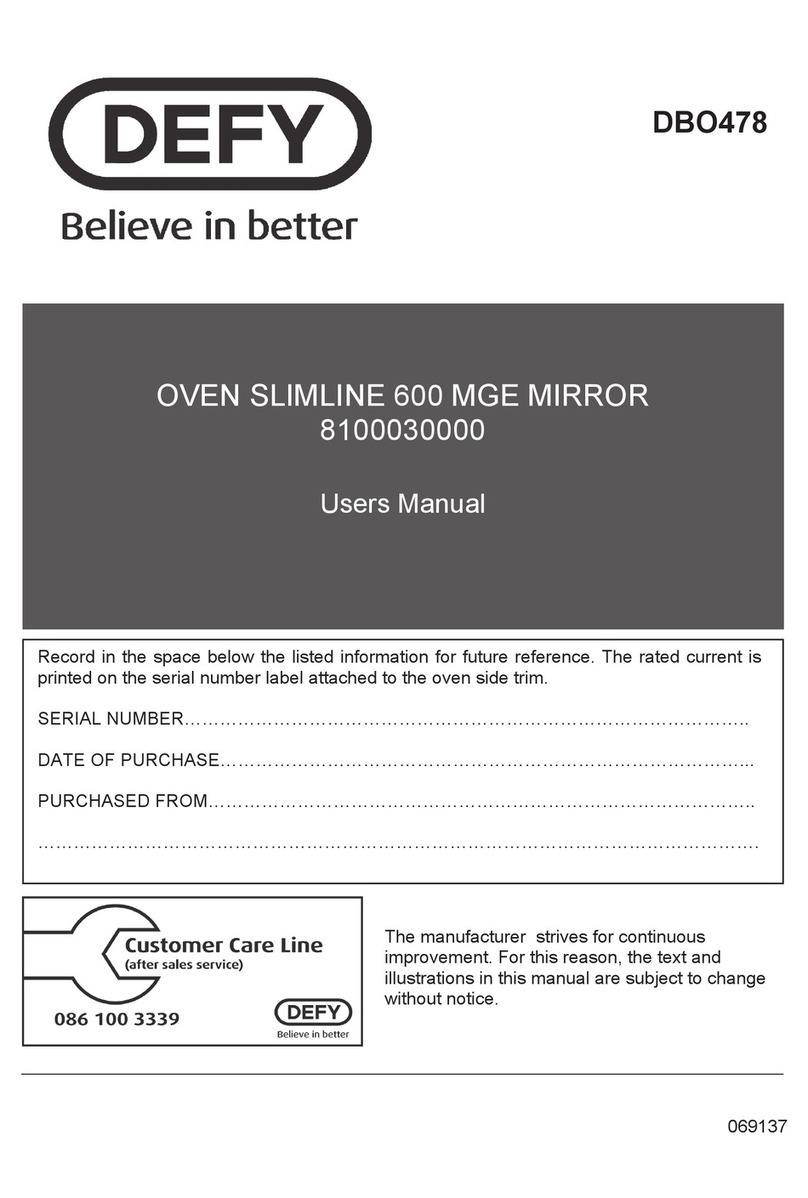
Defy
Defy DBO478 User manual
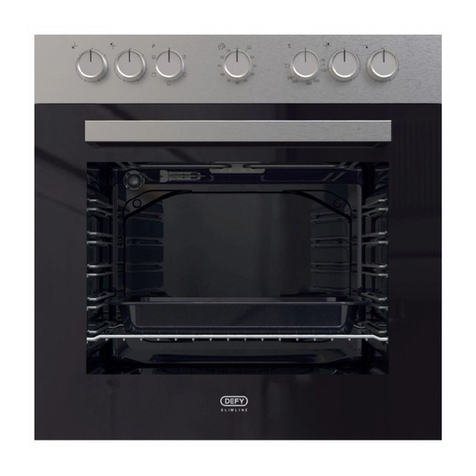
Defy
Defy Slimline Series User manual
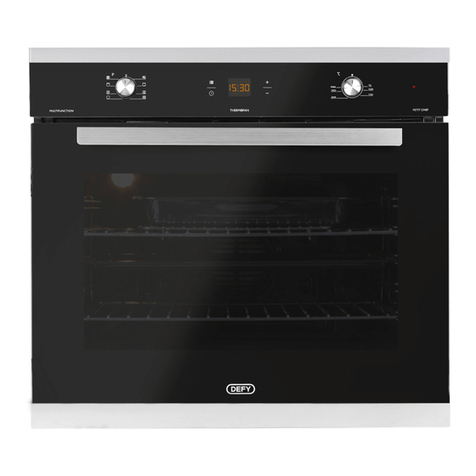
Defy
Defy GEMINI PETIT CHEF MULTIFUNCTION THERMOFAN User manual

Defy
Defy 600STE User manual
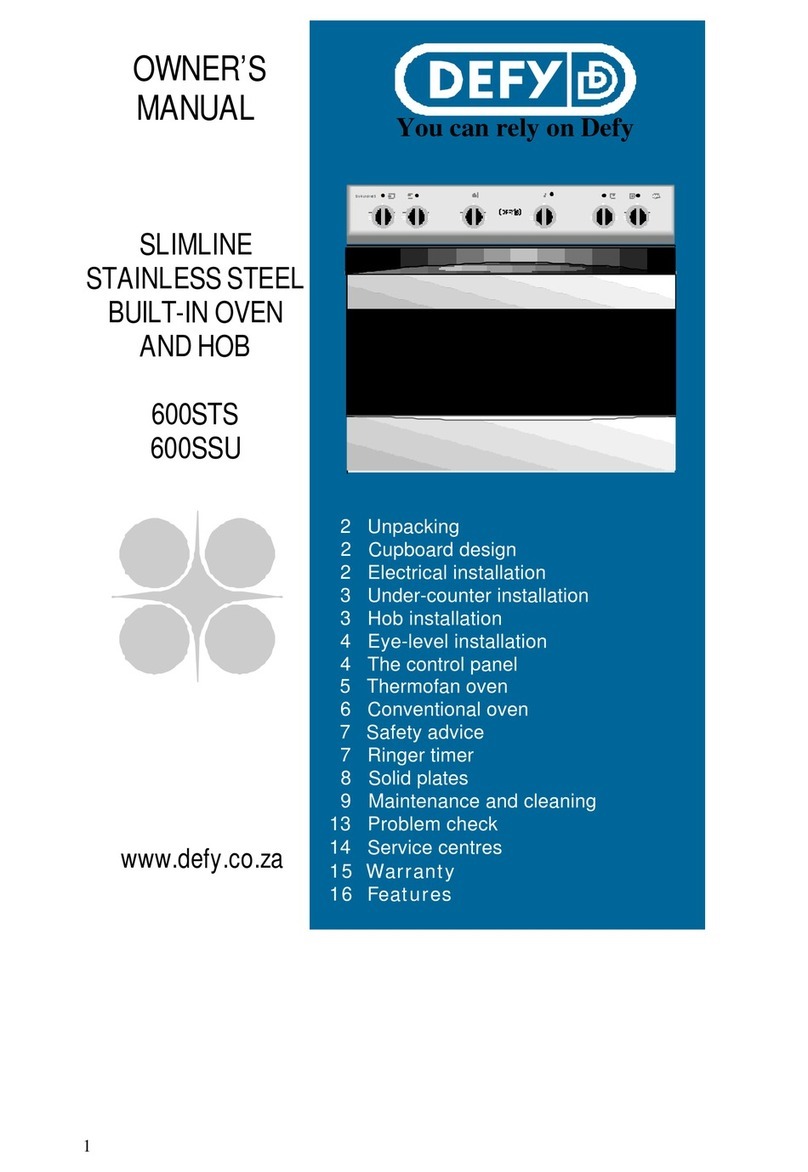
Defy
Defy 600STS User manual
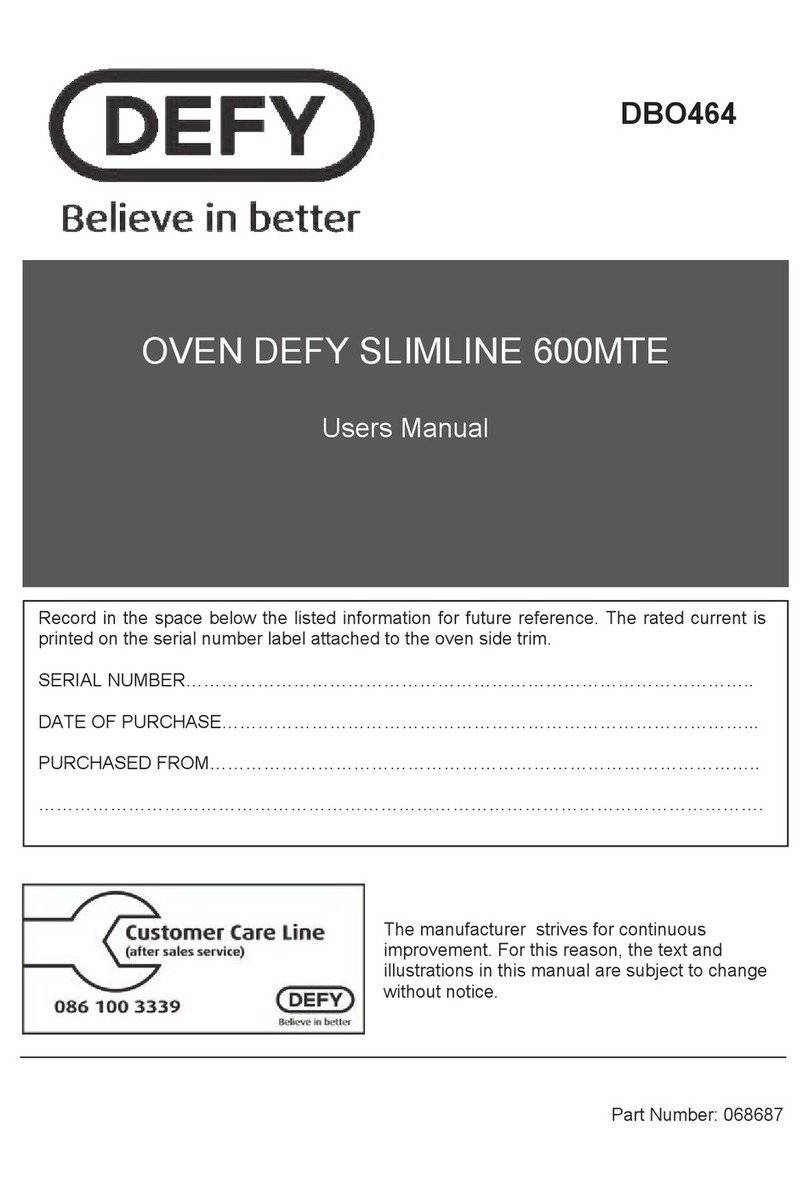
Defy
Defy Slimline 600MTE DBO464 User manual
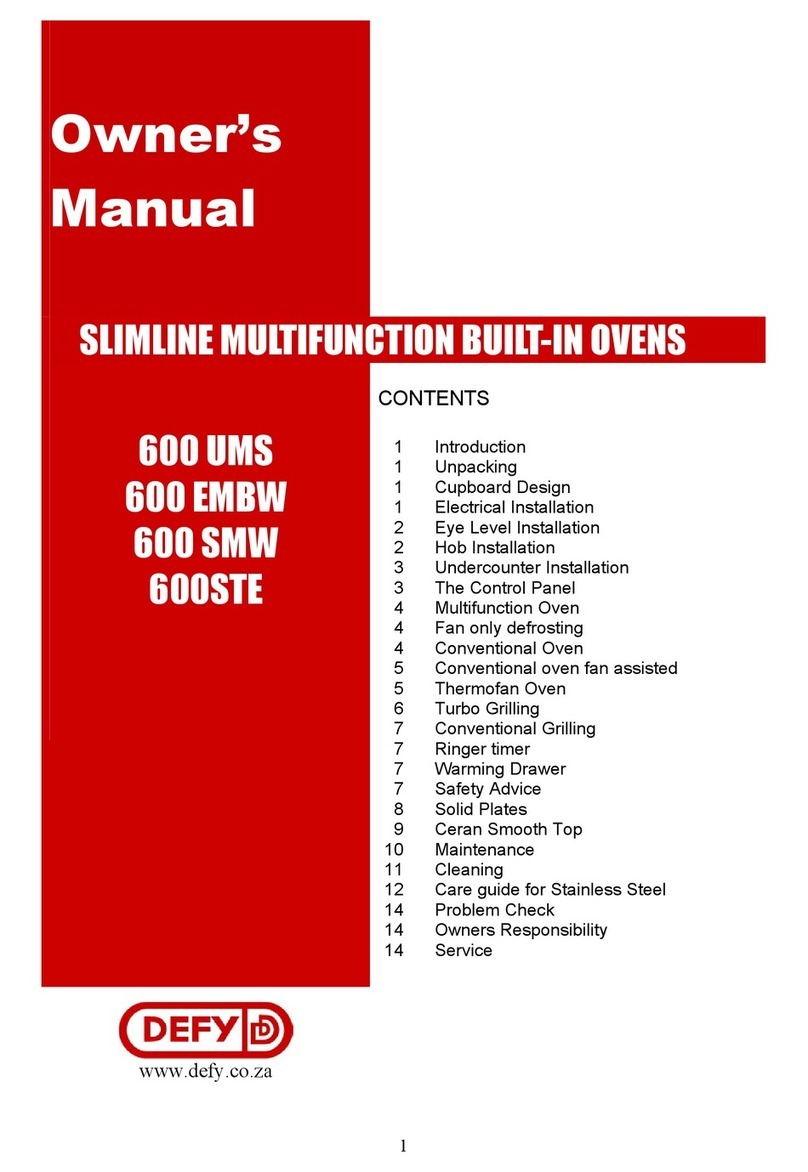
Defy
Defy 600 EMBW User manual

Defy
Defy 600 MGSE User manual
